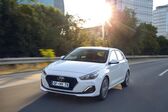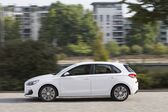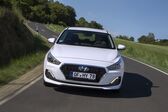Car Specs Hyundai i30 i30 III (facelift 2019) N 2.0 T-GDI (250 Hp)
Hyundai i30 III (facelift 2019) N 2.0 T-GDI (250 Hp) Specs
Hyundai i30 III (facelift 2019) N 2.0 T-GDI (250 Hp) has been in production since 2019 - 2020. Cars comes in Hatchback body types and can be suited with Petrol (Gasoline) engine types with a volume of 2L liters, engines produces a power of 250 Hp. Fuel consumption of Hyundai i30 III (facelift 2019) N 2.0 T-GDI (250 Hp) is 7.7 l/100 km. The overall dimensions of the car are 4335x1795x1451 mm, and the weight is from 1400-1480 kg.
General data Generation i30 III (facelift 2019) Modification N 2.0 T-GDI (250 Hp) Start of production 2019 year End of production 2020 year Powertrain Architecture Internal Combustion engine Body type Hatchback Seats 5 Doors 5 Fuel Type Petrol (Gasoline) Fuel consumption (economy), emissions Fuel consumption - urban 10.7 l/100 km Fuel consumption - extra urban 5.9 l/100 km Fuel consumption - combined 7.7 l/100 km CO2 emissions 176 g/km Emission standard Euro 6d - TEMP Performance specs Maximum speed 250 km/h Weight-to-power ratio 5.6 kg/Hp, 178.6 Hp/tonne Engine technical data Power 250 Hp @ 6000 rpm. Power per litre 125.1 Hp/l Torque 353 Nm @ 1450-4500 rpm. Engine location Front, Transverse Engine displacement 1998 cm3 Number of cylinders 4 Position of cylinders Inline Cylinder Bore 86 mm Piston Stroke 86 mm Number of valves per cylinder 4 Fuel System Direct injection Engine aspiration Turbocharger Power Electric Steering Suspension and brakes specs Drivetrain Architecture The Internal combustion engine (ICE) drives the front wheels of the vehicle. Drive wheel Front wheel drive Number of Gears (manual transmission) 6 Front brakes Ventilated discs, 330 mm Rear brakes Disc, 300 mm Assisting systems ABS (Anti-lock braking system) Steering type Steering rack and pinion Dimensions Length 4335 mm Width 1795 mm Height 1451 mm Wheelbase 2650 mm Front track 1557 mm Rear (Back) track 1566 mm Front overhang 905 mm Rear overhang 780 mm Ride height 136 mm Weights, volume and space Kerb Weight 1400-1480 kg Max. weight 1950 kg Max load 470-550 kg Trunk (boot) space - minimum 395 l Trunk (boot) space - maximum 1301 l Fuel tank capacity 50 l Max. roof load 80 kg Permitted trailer load with brakes (12%) 1600 kg Permitted trailer load without brakes 700 kg Permitted towbar download 80 kg
 Hyundai i30 III (facelift 2019) N 2.0 T-GDI (250 Hp) has been in production since 2019 - 2020. Cars comes in Hatchback body types and can be suited with Petrol (Gasoline) engine types with a volume of 2L liters, engines produces a power of 250 Hp. Fuel consumption of Hyundai i30 III (facelift 2019) N 2.0 T-GDI (250 Hp) is 7.7 l/100 km. The overall dimensions of the car are 4335x1795x1451 mm, and the weight is from 1400-1480 kg.
Hyundai i30 III (facelift 2019) N 2.0 T-GDI (250 Hp) has been in production since 2019 - 2020. Cars comes in Hatchback body types and can be suited with Petrol (Gasoline) engine types with a volume of 2L liters, engines produces a power of 250 Hp. Fuel consumption of Hyundai i30 III (facelift 2019) N 2.0 T-GDI (250 Hp) is 7.7 l/100 km. The overall dimensions of the car are 4335x1795x1451 mm, and the weight is from 1400-1480 kg.




